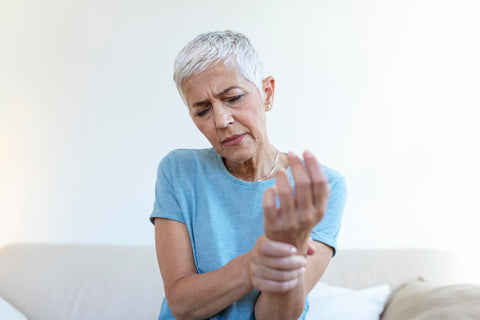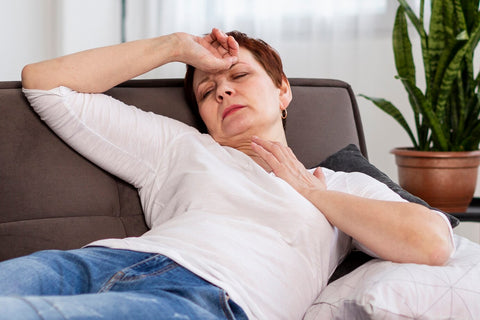Osteoporosis is a skeletal disease in which there is an imbalance between the formation and destruction of bone, with a decrease in bone mass density.
Numerous metabolic changes occur within the bone throughout life, alternating between phases of bone destruction and formation. These phases are regulated by different hormones, physical activity, diet, toxic habits and vitamin D, among other factors.
Under normal conditions, a person reaches a maximum amount of bone mass (“peak bone mass”) at the age of 20-30. From then on, there is a natural loss of bone mass.
Women are more likely to have osteoporosis because their peak bone mass (total amount of bone) is usually lower than that of men and with menopause bone loss accelerates (postmenopausal osteoporosis).
Osteoporosis is called a silent disease because it does not cause symptoms until bone loss is so severe that fractures occur.
According to data from the Spanish Society of Rheumatology (SER), it is estimated that osteoporosis affects around 75 million people in Europe, the United States and Japan.
This pathology is more common in women , although men can also suffer from it, especially if they are older.
In Spain, it is estimated that 2.5 million Spaniards over 50 years of age suffer from osteoporosis. The prevalence in the postmenopausal population is 25%, that is, one in four women suffers from this disease after menopause, which causes around 25,000 fractures per year.
Approximately one in three women and one in five men over the age of 50 will suffer at least one osteoporotic fracture in their remaining lifetime.
Osteoporosis and Menopause
Menopause and bone loss or osteoporosis are closely related.
Estrogens play an important role, as they are one of the most important regulators of the rate at which bone turnover occurs and, therefore, bone loss. When menopause occursand estrogen levels decrease, the bone remodeling process accelerates and with it the rate of bone loss. In postmenopause, bone is lost at a faster rate than when there is hormonal activity.
Thus, the estrogens produced by the ovary during a woman's fertile period protect our bones, which explains why osteoporosis occurs upon reaching menopause, or a progressive loss of bone mass and a deterioration in bone quality that predisposes women to a greater risk of fractures.
Always under medical criteria, it would be advisable to perform a bone densitometry that will measure bone mass once menopause has begun. The average rate of bone mass loss in the first 3-5 years is approximately 2-3% per year. In later periods, the rate of loss is lower (0.5-1% per year).
Tips to prevent osteoporosis:
Exercise every day . It is essential to exercise regularly, and even more so if we do it outdoors in the sun so that our body can synthesize vitamin D. In addition, sport improves blood circulation, promotes bone mineralization, maintains muscle strength, controls blood pressure and weight, prevents other diseases and promotes the activation of cellular immunity.
Sunbathing . Sun rays are an important source of vitamin D, which in turn promotes calcium absorption. Therefore, it is essential to expose yourself to sunlight. In order for vitamin D to be produced in the skin by the action of UVB rays from the sun, it is necessary to expose yourself to the sun without sun protection about 3 times a week for 10 minutes and avoid the hours of greatest solar radiation. Dermatologists agree with this practice as long as this time is not exceeded and immediately afterward we protect ourselves with sun cream or end our exposure to the sun.
Follow a healthy diet . One that is also balanced and varied:
Include protein . Our diet must contain an adequate protein intake, especially at advanced ages, since a progressive loss of muscle mass occurs.
Prioritise fish over meat . It is preferable to eat more fish than meat. In this regard, specialists suggest varying between white and blue fish.
Eat dairy products or calcium-enriched alternatives every day . Our daily diet should include 3 servings of dairy products or calcium-enriched foods so that our body has enough calcium. This mineral is also found in nuts and fish bones, so we can include canned fish or smaller fish, such as anchovies and sardines, among others.
Incorporate foods with vitamin D. To provide an extra dose of this vitamin, we can add foods such as tuna in oil, smoked or fresh salmon, anchovies, sardines, mackerel, swordfish and anchovies, among others.
Vegetables are a must in your diet . Specialists recommend eating 2 servings of vegetables, preferably green leafy vegetables, every day for their anti-inflammatory effect. Once a day, they encourage you to eat them raw, as this provides more fibre, which is good for intestinal transit.
Eat more plant-based foods . In addition to vegetables, a diet to prevent osteoporosis should include legumes, fruits and cereals. Eating these foods is associated with greater bone density at an older age and in women who have gone through menopause.
Don't forget about fruit . It is advisable to eat 3 portions a day, trying to choose seasonal fruit. Whenever possible, it is also recommended to eat the skin of the fruit, as it contains the most fibre.
Don't overindulge in salt . It is important to moderate salt consumption, so we should pay special attention to canned foods. Doctors advise replacing salt with vinegar, garlic, onion, lemon or spices.
Stay hydrated . It is recommended to drink around one to one and a half liters of water a day. Good hydration does not include soft drinks or alcohol. Experts advise avoiding excessive consumption of these drinks to prevent osteoporosis.
Avoid drinking more than one cup of coffee a day . Caffeine can interfere with calcium absorption due to its diuretic effect, which promotes the elimination of calcium through urine.
Do not smoke . Tobacco is very harmful to bones, especially in women, who have lower bone mass. In fact, tobacco is considered a risk factor for osteoporosis, as it affects the metabolism of calcium and vitamin D, the decrease in estrogen with early menopause and the increase in androgens.
Osteoporosis is more common in women and increases during menopause due to the decrease in the protective effect of estrogen hormones on the bone during menopause. At Madequa we are concerned with raising awareness about these issues, promoting prevention and care for bone health in postmenopause.
References
Słupski W, Jawień P, Nowak B. Botanicals in Postmenopausal Osteoporosis. Nutrients . 2021;13(5):1609. doi:10.3390/nu13051609.
15 tips to prevent osteoporosis. (nd). Your Health Channel.
Barnaclínic. (2021b, October 20). Osteoporosis and menopause, closely related. Women's Health Blog.
Mora, AC (2022, October 21). Osteoporosis. CuídatePlus.
SER. (2024, March 22). Osteoporosis: what it is, symptoms, diagnosis and treatment. Inforeuma.




Comments (0)
There are no comments for this article. Be the first one to leave a message!